October, 2003
Polearms used in Nethack
Polearms were developed in warfare for combatting mounted soldiers, and
those with heavy armor. The polearms (arms on poles) increased leverage
for cutting the armor, and increased reach for reaching above the horse.
As time went on the various different weapon types borrowed heavily from
each other and began to look like each other, which has lead to a great deal
of confusion over classification. If you search the internet
now for examples of these weapons, you are likely to see weapons completely
mislabeled as something different.

The halberd (sample halberd heads pictured above)
was a mainstay weapon in many armies for a long time.
The halberd is a poleaxe, meaning an axe on a pole. It's main identifying
feature is that the blade is always angled slightly downward,
which explains Nethack's description of an angled poleaxe.
In addition to the axe, halberds also have both a spear tip, and spike or
hook on the rear for penetrating armor or hooking. A nice three-in-one
weapon. Due to the popularity of this weapon, there are a wide variety
of different styles, although some of the coolest were only parade weapons.
The halberd is one of the best Nethack weapons, and this is consistent with
its role in real warfare.

Nethack calls the bardiche a "long poleaxe" and that is exactly
right, if you assume that the "long" applies to "axe" and not "pole".
A bardiche is nothing more than a long axe blade on a stick. The
cutting blade was typically two feet long or more, and usually attached to
the pole in two places (in the middle and the bottom). But it is
mounted on one of the shortest poles for a polearm, only about five
feet. So "short poleaxe" would be accurate also. This simple weapon's
advantage was in its size and weight, not its subtlety. I think Nethack
gets the weight wrong -- a bardiche should be heavier than a halberd.
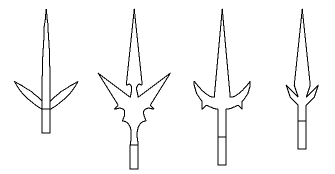
The spetum is a spear, with two more knife blades stuck on the
sides. Nethack's "forked polearm" is vaguely accurate, but forked weapons
would more typically have side prongs that reach all the way up to the
top. Over
time variations were added and it more strongly resembled the next weapon.
(I'm not sure if the spetum grew into it, or if they were developed
independently.) Nethack gives this an advantage with large monsters,
which doesn't quite make sense to me, as it is supposed to be a lighter
polearm.
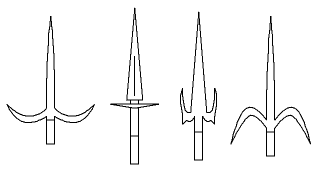
The ranseur, the "hilted polearm", is essentially a spear with a
hilt. The hilt served primarily to block opponents weapons, and possibly
trap the weapon for disarming. The hilt was sometimes also used secondarily
as an alternate way to attack.
The hilt often hooked backwards
also, so that it could be used as a hook. The ranseur was probably
an all around better weapon than the spetum, but this is not the case
in Nethack. In a perfect universe, nethack would give this weapon an
advantage when fighting monsters that use weapons, as that is where the
hilt is useful.

The partisan also winds up looking much like the ranseur and spetum.
Originally the partisan was a spear with small double axe blades added below
it. This basic form is shown in the first partisan above, however you won't
likely ever see a partisan that looks like this. The other forms are more
typical. Note that while some of them look like spetums, they present
broader protrusions than the knife-like spetum prongs.
The partisan is also more
likely to have a flat bladed tip, rather than the spiky blade of the spetum
and ranseur. Over time partisans (or weapons
called partisans) became more ornamental and ceremonial, which may explain
why it is one of the weaker polearms, and also why it is referred to as a
"vulgar polearm".
Perhaps one good way to differentiate between the spetum, the partisan,
and the ranseur is to look for the edges on the prongs. Typically,
a ranseur would have no edges, a partisan would have edges only facing out,
and a spetum would have edges on both sides of the protrusions.
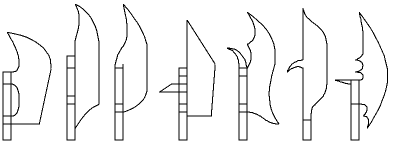
Nethack has it just right referring to the voulge as a "pole cleaver",
as this weapon probably was invented as
a meat cleaver on a pole. The voulge may look somewhat like a bardiche,
but the blade is much shorter, and the shaft is longer. It also may tend
to look like the next weapon, but would generally have a broader blade.
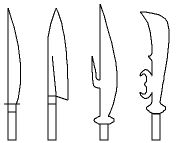
If you could put a cleaver on a stick, why not just a knife? The glaive,
is basically just that, a knife on a stick, or as Nethack calls it, a
"single-edged polearm". Glaives were not the best weapons, and Nethack gives
them too much credit. They should also be one of the lightest polearms.

In Nethack the glaive is called a naginata if you are playing as a
samurai. However a naginata was actually a japanese polearm which used
(the equivalent of) a top-quality samurai sword at the end of the pole,
and the weapon was backed up by a long-developed and rigorous martial art,
and when combined with this expertise it was a formidable weapon.
Perhaps this is why Nethack gives the glaive so much credit. But in my
opinion they should be two different weapons.
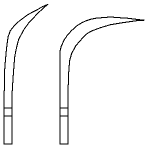
While we're sticking random things on poles, lets talk about
the fauchard,
which Nethack calls a "pole sickle". This is because this weapon
had a curved blade, with the sharp edge on the inside of the curve. This
was a really stupid weapon design, and Nethack rightly doesn't give it
much power.

The guisarme, like the voulge, started out as a peasant's weapon,
made from a tool on a stick. In this case the tool is a pruning hook,
which is where it gets its description. While it was a somewhat useful
cheap weapon, the lack of a spear point was a significant liability.
It was good for pulling riders off of their mounts, but what do you do
once they're off?
It evolved to some degree, sometimes adding a reverse spike, but eventually
guisarme became a generic term for any weapon with a hook, such that you had
voulge-guisarmes, and glaive-guisarmes.

This leads us to bill-guisarmes.
Bill hooks were english weapons similar in
shape to the guisarme, but perhaps with somewhat less hook in general.
They followed a different evolution, such that any weapon that was similar
to a glaive or fauchard, but with extra bits thrown in, was often
called a bill. So, in terms of origination, bill-guisarme would be a
bit redundant, but in terms of later meaning, a bill-quisarme was a bladed
weapon with multiple sharpened edges and spikes, and with a hook.
Nethack should give these weapons more credit, they
were very versatile, and used over long periods of time, second only to the
halberd.
There is a lot of confusion out there on guisarmes and bill-guisarmes.
Often the bill-guisarme is called simply a guisarme. Also, Many pictures
purporting to be guisarmes are actually fauchard-forks, which is a fauchard,
with a sharp spear point added to the back of the blade.

The lucern hammer is vaguely similar to the halberd, only instead of
an axe blade, it presents a three-pronged hammer to it's victim. Hence
the "pronged polearm" designation.

The bec do corbin looks extremely similar to the lucern hammer,
however the hammer side was sometimes blunt instead of pronged. The
distinguishing characterstic though is that the spike was a thick
beak-like shape designed only for puncturing (armor, or whatever). This
is why it is the "beaked polearm". The beak was the primary mode of attack,
the hammer or claw was secondary. The spear tip was also generally less
pointy than that of the lucern hammer.
Note that the source code lumps the dwarvish mattock in with the polearms.
I'm not sure why. But this designation is thankfully not used in determing
its weapon type for skills (it's a pick).
Also the lance is a polearm, although it served a very different
purpose from other polearms, because it was used by mounted soldiers
instead of against them.
Links
Notes on Nethack Weapon Skills
What is the Best Nethack Artifact?
Medieval Pole Arms - Minas Morgul
Polearms












